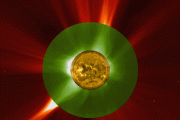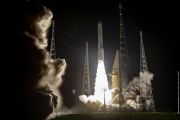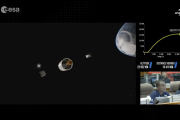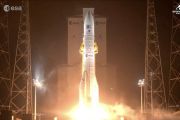
Copernical Team
Fermi captures dynamic gamma-ray sky in new animation
 Cosmic fireworks, invisible to our eyes, fill the night sky. We can get a glimpse of this elusive light show thanks to the Large Area Telescope (LAT) aboard NASA's Fermi Gamma-ray Space Telescope, which observes the sky in gamma rays, the highest-energy form of light.
This animation shows the gamma-ray sky's frenzied activity during a year of observations from February 2022 to February 202
Cosmic fireworks, invisible to our eyes, fill the night sky. We can get a glimpse of this elusive light show thanks to the Large Area Telescope (LAT) aboard NASA's Fermi Gamma-ray Space Telescope, which observes the sky in gamma rays, the highest-energy form of light.
This animation shows the gamma-ray sky's frenzied activity during a year of observations from February 2022 to February 202 Powerful solar eruption on far side of Sun still impacted Earth
 A massive eruption of solar material, known as a coronal mass ejection or CME, was detected escaping from the Sun at 11:36 p.m. EDT on March 12, 2023.
The CME erupted from the side of the Sun opposite Earth. While resarchers are still gathering data to determine the source of the eruption, it is currently believed that the CME came from former active region AR3234. This active region was o
A massive eruption of solar material, known as a coronal mass ejection or CME, was detected escaping from the Sun at 11:36 p.m. EDT on March 12, 2023.
The CME erupted from the side of the Sun opposite Earth. While resarchers are still gathering data to determine the source of the eruption, it is currently believed that the CME came from former active region AR3234. This active region was o Scientists have new tool to estimate how much water might be hidden beneath a planet's surface
 In the search for life elsewhere in the Universe, scientists have traditionally looked for planets with liquid water at their surface. But, rather than flowing as oceans and rivers, much of a planet's water can be locked in rocks deep within its interior.
Scientists from the University of Cambridge now have a way to estimate how much water a rocky planet can store in its subterranean reser
In the search for life elsewhere in the Universe, scientists have traditionally looked for planets with liquid water at their surface. But, rather than flowing as oceans and rivers, much of a planet's water can be locked in rocks deep within its interior.
Scientists from the University of Cambridge now have a way to estimate how much water a rocky planet can store in its subterranean reser The first bubble in the intergalactic stew
 Astrophysicists using W. M. Keck Observatory on Maunakea in Hawai?i have discovered a galaxy protocluster in the early universe surrounded by gas that is surprisingly hot.
This scorching gas hugs a region that consists of a giant collection of galaxies called COSTCO-I. Observed when the universe was 11 billion years younger, COSTCO-I dates back to a time when the gas that filled most of th
Astrophysicists using W. M. Keck Observatory on Maunakea in Hawai?i have discovered a galaxy protocluster in the early universe surrounded by gas that is surprisingly hot.
This scorching gas hugs a region that consists of a giant collection of galaxies called COSTCO-I. Observed when the universe was 11 billion years younger, COSTCO-I dates back to a time when the gas that filled most of th Spring Past the Marker Band: Sols 3776-3777
 Our Tapo Caparo drill campaign is officially concluded and our wheels are turning again! Specifically, we're back on the strategically-created route up Aeolis Mons (aka Mount Sharp), "paving" the path as we go. As a personal habit, when we leave a distinct area I like to look back at the road behind and all we've accomplished along the way. So, a quick sentimental summary... we drove our wheels
Our Tapo Caparo drill campaign is officially concluded and our wheels are turning again! Specifically, we're back on the strategically-created route up Aeolis Mons (aka Mount Sharp), "paving" the path as we go. As a personal habit, when we leave a distinct area I like to look back at the road behind and all we've accomplished along the way. So, a quick sentimental summary... we drove our wheels Geologists Love a Good Contact: Sols 3773-3775
 With a jam packed three-sol plan on her plate, Curiosity won't have time to kick back and relax this weekend! The rover is heading south across the Marker Band and is currently sitting in front of a lovely view that includes a contact between two types of bedrock.
The lower section of bedrock consists of very thin, horizontal layers, as though you were looking at the edge of a thick stack
With a jam packed three-sol plan on her plate, Curiosity won't have time to kick back and relax this weekend! The rover is heading south across the Marker Band and is currently sitting in front of a lovely view that includes a contact between two types of bedrock.
The lower section of bedrock consists of very thin, horizontal layers, as though you were looking at the edge of a thick stack NASA connects all major structures of Artemis II Moon Rocket Core Stage
 Teams at NASA's Michoud Assembly Facility in New Orleans have fully integrated all five major structures of the Space Launch System (SLS) rocket's core stage for Artemis II, the first crewed Artemis mission that will send four astronauts around the Moon and return them home. Technicians joined the engine section to the rest of the rocket stage March 17. Next, teams will integrate the four RS-25
Teams at NASA's Michoud Assembly Facility in New Orleans have fully integrated all five major structures of the Space Launch System (SLS) rocket's core stage for Artemis II, the first crewed Artemis mission that will send four astronauts around the Moon and return them home. Technicians joined the engine section to the rest of the rocket stage March 17. Next, teams will integrate the four RS-25 China's Long March 11 rocket conducts 16 consecutive successful launches
 China's Long March 11 carrier rocket has successfully carried out 16 consecutive launches as of Wednesday, according to its developer.
A Long March 11 rocket on Wednesday evening sent the Shiyan 19 satellite into space, marking the rocket's 16th successful launch since it was put into service in 2015, according to the China Academy of Launch Vehicle Technology under the China Aerospace Sci
China's Long March 11 carrier rocket has successfully carried out 16 consecutive launches as of Wednesday, according to its developer.
A Long March 11 rocket on Wednesday evening sent the Shiyan 19 satellite into space, marking the rocket's 16th successful launch since it was put into service in 2015, according to the China Academy of Launch Vehicle Technology under the China Aerospace Sci Scientist reveals goals for future lunar research station
 Scientists have proposed several objectives for a future international lunar research station, including moon-based Earth observation and lunar resource utilization, the China Science Daily reported on Friday.
Zou Yongliao, head of the lunar and deep space exploration division of the Chinese Academy of Sciences, revealed the goals at a recent national space conference.
China plans to
Scientists have proposed several objectives for a future international lunar research station, including moon-based Earth observation and lunar resource utilization, the China Science Daily reported on Friday.
Zou Yongliao, head of the lunar and deep space exploration division of the Chinese Academy of Sciences, revealed the goals at a recent national space conference.
China plans to Scientists and students to develop the first Estonian lunar rover
 Researchers and students of the Tartu Observatory at the University of Tartu started the development of Estonia's first lunar rover, designed to take Estonian technology to the Moon at the end of this decade or the beginning of the next. The first step is a feasibility study to determine which lunar rover can be built in Estonia and realistically delivered to the surface of the Moon. It will als
Researchers and students of the Tartu Observatory at the University of Tartu started the development of Estonia's first lunar rover, designed to take Estonian technology to the Moon at the end of this decade or the beginning of the next. The first step is a feasibility study to determine which lunar rover can be built in Estonia and realistically delivered to the surface of the Moon. It will als 
































